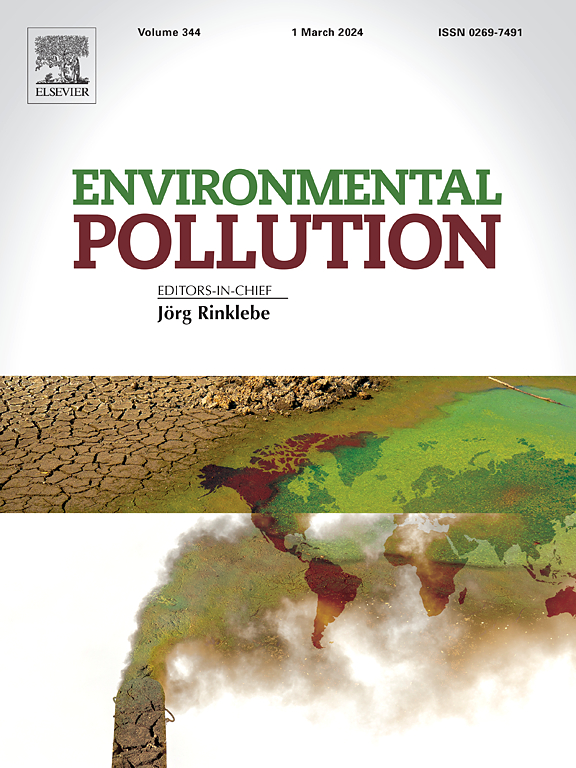塑料粒径谱:评估陆地-水交错带塑料颗粒的粒径结构
IF 7.6
2区 环境科学与生态学
Q1 ENVIRONMENTAL SCIENCES
引用次数: 0
摘要
不同类型和大小的塑料污染了地球的大部分环境系统。在这里,我们使用尺寸光谱分析(SSA)来评估和表征20个城市湖泊陆水交错带塑料污染的尺寸-频率模式。我们首先测试了一个普遍的假设,即环境中的塑料颗粒反映了一种可检测的和反向的尺寸频率模式,因为大型塑料经常分解成越来越小的碎片。为了进一步评估SSA的效用,我们测试了特定湖泊模型的斜率(λ)和截距(Γ)系数是否敏感,以区分湖区之间的趋势。总体而言,我们的研究结果检测到颗粒计数(# / m2)和颗粒长度之间的总体反比关系,证实了所有聚合数据中存在塑料尺寸谱。通过(1)将薄膜与较厚的塑料碎片分开,以及(2)分别评估采样环境(即高地植被、岸线沉积物、近海沉积物),我们进一步提高了SSA模型的解释力。这样做揭示了统计上不同的大小-频率梯度,追踪了电影和碎片从陆地到水的转变。对SSA模型的分析和比较也证实了系数足够敏感,可以检测出湖区之间的差异。总而言之,SSA框架成功地用于检测和描述环境中塑料污染的几种模式。这种分析框架有望对所有塑料进行假设驱动的研究,而不是专注于小颗粒或大颗粒。本文章由计算机程序翻译,如有差异,请以英文原文为准。


The plastic size spectra: Assessing the size structure of plastic particles across the land-water ecotone
Plastics of different types and sizes pollute most of Earth's environmental systems. Here, we used size spectra analysis (SSA) to evaluate and characterize size-frequency patterns of plastic pollution across the land-water ecotone of 20 urban lakes. We first tested the general hypothesis that plastic particles in the environment reflect a detectable and inverse size-frequency pattern as large plastics regularly breakdown in increasingly smaller pieces. To further evaluate the utility of SSA, we tested whether slope (λ) and intercept (Γ) coefficients from lake-specific models were sensitive to distinguish trends among lake zones. Overall, our findings detected an overall inverse relationship between particle counts (#/m2) and binned particle length, confirming the presence of a plastic size spectra for all aggregated data. We further improved the explanatory power of SSA models by (1) separating thin films from thicker plastic fragments and by (2) assessing sampling environments (i.e., upland vegetation, shoreline sediments, offshore sediments) separately. Doing so revealed statistically distinct size-frequency gradients that tracked the shift from land to water for both films and fragments. Analysis and comparison of SSA models also confirmed that coefficients were sensitive enough to detect differences among lake zones. All told, the SSA framework was successfully used to detect and describe several patterns of plastic pollution in the environment. This analytic framework holds promise for developing hypothesis-driven studies to all plastics rather than focusing on small or large particles.
求助全文
通过发布文献求助,成功后即可免费获取论文全文。
去求助
来源期刊

Environmental Pollution
环境科学-环境科学
CiteScore
16.00
自引率
6.70%
发文量
2082
审稿时长
2.9 months
期刊介绍:
Environmental Pollution is an international peer-reviewed journal that publishes high-quality research papers and review articles covering all aspects of environmental pollution and its impacts on ecosystems and human health.
Subject areas include, but are not limited to:
• Sources and occurrences of pollutants that are clearly defined and measured in environmental compartments, food and food-related items, and human bodies;
• Interlinks between contaminant exposure and biological, ecological, and human health effects, including those of climate change;
• Contaminants of emerging concerns (including but not limited to antibiotic resistant microorganisms or genes, microplastics/nanoplastics, electronic wastes, light, and noise) and/or their biological, ecological, or human health effects;
• Laboratory and field studies on the remediation/mitigation of environmental pollution via new techniques and with clear links to biological, ecological, or human health effects;
• Modeling of pollution processes, patterns, or trends that is of clear environmental and/or human health interest;
• New techniques that measure and examine environmental occurrences, transport, behavior, and effects of pollutants within the environment or the laboratory, provided that they can be clearly used to address problems within regional or global environmental compartments.
 求助内容:
求助内容: 应助结果提醒方式:
应助结果提醒方式:


